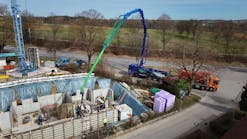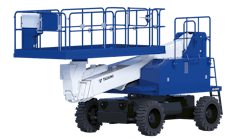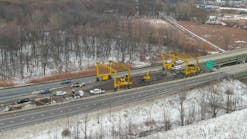From logging and national park conservation to fire prevention, property and habitat protection, too many forest management tasks are still done the old-fashioned way: with shovel, chainsaw and backbreaking sweat. Even when equipment is used to pick up, move or stack trees, logs, brush, or other fire hazards, there are drawbacks whenever these tasks require control and efficiency. Traditional bucket attachments, for instance, tend to scoop excess dirt, have trouble holding unwieldy loads, and are largely ineffective at tasks requiring fine control such as raking limbs or debris.
In response, those responsible for managing private and public forestland are adding a versatile new attachment — the hydraulic grapple rake — to their loaders, tractors and skid steers. Since it's much more efficient than manual labor and more adaptable than the bucket, the grapple rake, which hydraulically opens, closes and moves its jaws of spaced metal tines, is becoming indispensable. It can remove trees, logs and brush or surface rake limbs and debris without removing needed topsoil or piling up unnecessary dirt. It can dig out roots and stumps. It can securely pick up, move and stack logs, trees or irregular loads up to several thousand pounds.
With intertwined teeth, it can also grab and place material down to 3 inches, and reach within inches of desired forest habitat without disturbing it to rake, lift, drag, or haul loads. It can even create piles and pick them up from the front or lift them from the top, which is especially helpful when loading debris piles onto trailers or tending the piles for burn disposal.
Bob Chapman was faced with the unwelcome task of removing over 300 trees on his 70-acre, Steamboat, Colo., property due to beetle kill. Due to the enormity of the task, he hired a commercial timber company to do the work.
"It looked like a war zone with logs, branches and stumps everywhere," Chapman said. "I wondered how they were going to clean up the huge mess without destroying habitat for the living trees and adjoining grassland. I was so impressed with the way a skid-steer-mounted grapple rake navigated living trees while removing huge loads of debris that I talked the timber company into letting me operate it for a few days."
He used the hydraulic grapple rake manufactured by Colville, Wash.-based AnBo Manufacturing, which specializes in high-quality designed products for tractors, loaders and skid steers. While their attachment operates like a bucket in that it can be raised and lowered, and rolled forward and backward, it has a third hydraulic function to open and close its jaws.
To handle ongoing beetle kill and fire prevention tasks, Chapman decided to buy a grapple rake for his multi-terrain loader. AnBo Manufacturing built the grapple rake to fit Chapman's loader. He chose a 6-foot grapple rake with 6-inch tine spacing to allow dirt but not brush or debris to sift through the rake's tines.
Previously, Chapman had used a four-wheel-drive tractor with a bucket attachment to remove debris with unsatisfactory results. "Because the bucket lacked finesse, it left holes and skinned spots that removed topsoil and made it difficult for decorative grassland to grow back," he explains. "Since the grapple rake just scrapes debris off of the top and can back rake with accuracy, the grass grew back beautifully in one season."
Chapman has also put the hydraulic grapple rake to good use for fire mitigation on a 5-acre, Nederland, Colo., property. While trying to clear a defensible space around the property before, he tried to remove flammable juniper ground spread and preserve the desired aspen. But as the juniper grew among rocky outcroppings, it had proved difficult.
"I hired a crew to remove the juniper, but it was basically pickax, shovel, sweat, and cuss," Chapman said. "You couldn't put a chainsaw to it because it grew among rocks and dirt. The needles went right through leather gloves. After two weeks of backbreaking labor, when they'd cleaned up less than 1/10 of an acre, they finally quit.
"Using the grapple rake, I was able to pull up the juniper by the roots so it wouldn't grow back — right from its rocky outcroppings. My loader has a push force of about 6,000 pounds, and several times I stalled it pushing on big rocks, but the grapple rake was fine. It's strong enough to handle whatever you throw at it."
As AnBo uses a special type of steel that has twice the yield strength (resistance to bending) and a much higher Brinell hardness rating (resistance to wear) than T1 steel, it satisfied his need for strength. The added strength preserves more lift and payload capacity than similar products, and makes the grapple rake light enough for mini or compact skid steers or tractors.
With the grapple rake, Chapman single-handedly cleared a defensible space around his property. "I ended up taking out 215 cubic yards of slash and debris, and loaded it onto trailers in about 100 hours," he said. "It's great at back raking, grabbing, stacking, and piling, whatever you need. Not only did I save over $10,000 in labor, but I also lowered my insurance from $23,000 to $4,000 annually. I don't know how I'd have done the job any other way," Chapman said.
When Hurricane Katrina toppled thousands of trees on Tom Hauptmann's property an hour from New Orleans, La., it took him and his wife three days to go from their driveway to their mailbox, cutting and moving downed trees along the way. While Hauptmann's co-workers resorted to dragging trees with a tractor and chain, he used a front-end loader with a four-way clamshell bucket to accomplish the task. Still, the inefficiency of the effort frustrated him.
"I could pick up logs, but it was always dicey," explains Hauptmann. "Because the clamshell bucket had no teeth or curvature, I could pinch the logs but not really grip them. The load would slip out when it got imbalanced, so it was slow going and I had to be careful. When a load slipped, it not only took extra time to pick it up, but also to clean up the debris left behind."
He was also dissatisfied with the bucket's inability to rake limbs, leaves and debris from the ground without scooping up dirt. Because the dirt mixed with debris in piles to be burned for disposal, the piles burned slowly, incompletely or with too much smoke.
Hauptmann turned to a 6-foot, hydraulic AnBo grapple rake with 6-inch tine spacing. "The grapple rake is strong enough to pick up anything your machine is capable of," Hauptmann said. "My limit is blowing out the tires on my front-end loader." Hauptmann's grapple rake was strong enough to pick up and carry 40-foot sections of tree up to 18 inches in diameter, which he estimates weighed up to 4,000 pounds. This, he found, was much faster and easier than cutting logs into smaller sections, then dragging or carrying them separately.
Because his control and grip are better with the grapple rake, he's now more efficiently cleaning up and managing his property. He's using it to pick up trees, logs, limbs, brush, and debris, and even uses it to dig up stumps and roots.
"Unlike bucket jaws that essentially pinch, the grapple rake wraps around a load," Hauptmann explained. "Its teeth and curvature are better for grabbing and grasping. It operates like a hand and gives much better control and holding power. You can grab so much more with the grapple rake."
One job in particular proved the grapple rake's efficient capacity to Hauptmann. Inadvertently, he had built a burn pile of trees and logs for disposal under a power line. He realized he had to move them. "With the bucket, such a job would've taken me 20 loads to finish," he said. "With the AnBo grapple rake, it took me just five loads to move the entire pile. It made a two-hour project a 20-minute one."
He also finds the grapple rake useful for quickly removing "nuisance trees and brush," which tend to have shallow roots. "I simply put the teeth down and rip out the roots and all so they don't grow back," he said. To gather limbs, he simply slides the grapple rake's teeth along the ground until there's a big enough load to carry to the burn pile. "I could never do that with a bucket because things would slip under and go every which way," Hauptmann said.
Hauptmann finds the grapple rake's flexibility extends to placing and shifting objects in the burn pile for a cleaner, less smokey and more complete burn. "I can pick up and replace items in the burn pile, shift ashes, whatever is necessary to keep it burning properly," he says.
Whether for logging, national park conservation, fire prevention, or forest management, the grapple rake is making traditionally tedious cleanup tasks faster, safer and easier with its unique combination of strength, control and flexibility. Those responsible for such work are finding that substituting its technology for costly, time-consuming labor is a good investment that continues to pay back, year after year.




